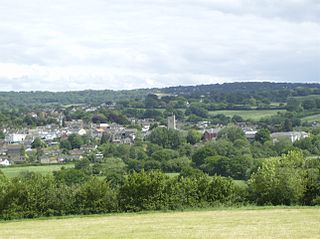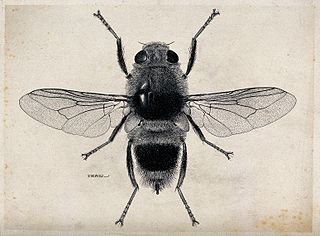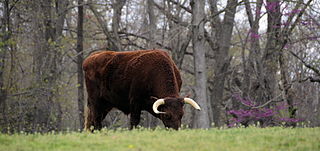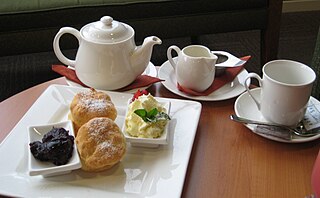
Axminster is a market town and civil parish on the eastern border of the county of Devon in England, some 28 miles (45 km) from the county town of Exeter. The town is built on a hill overlooking the River Axe which heads towards the English Channel at Axmouth, and is in the East Devon local government district. At the 2001 census, it had a population of 5,626, increasing to 5,761 at the 2011 census. The town contains two electoral wards the total sum of both wards being a population of 7,110. The market is still held every Thursday.

The Red Poll is a dual-purpose breed of cattle developed in England in the latter half of the 19th century. The Red Poll is a cross of the Norfolk Red beef cattle and Suffolk Dun dairy cattle breeds.

The Hereford is a British breed of beef cattle that originated in the county of Herefordshire, in the West Midlands of England. It has been exported to many countries, and there are more than five million purebred Hereford cattle in over fifty nations worldwide. The Hereford cattle export trade began from United Kingdom in 1817, starting in Kentucky, United States, spreading across the United States and Canada through Mexico to the great beef-raising countries of South America. Today, Hereford cattle dominate the world scene from Australasia to the Russian steppes. They can be found in Israel, Japan and throughout continental Europe and Scandinavia, in the temperate parts of Australia, Canada, the United States, Kazakhstan and Russia, in the centre and east of Argentina, in Uruguay, in Chile and New Zealand, where they make up the largest proportion of registered cattle. They are found all around Brazil and they are also found in some Southern African countries. They originally found great popularity among ranchers of the American Southwest, testament to the hardiness of the breed; while originating in cool, moist Britain, they have proven to thrive in much harsher climates on nearly every continent.

Heck cattle are a hardy breed of domestic cattle. These cattle are the result of an attempt by the Heck brothers to breed back the extinct aurochs from modern aurochs-derived cattle in the 1920s and 1930s. Controversy revolves around methodology and success of the programme. There are considerable differences between Heck cattle and the aurochs in build, height, and body proportions. Furthermore, there are other cattle breeds which resemble their wild ancestors at least as much as Heck cattle.

Julian White MBE is an English farmer, best known for his time playing professional rugby union as a prop for Leicester Tigers and England. White was regarded as an aggressive tighthead prop ,one of the most powerful forwards in the game, and for his destructive scrummaging.
Devon is a county in England.

Warble fly is a name given to the genus Hypoderma, large flies which are parasitic on cattle and deer. Other names include "heel flies", "bomb flies" and "gadflies", while their larvae are often called "cattle grubs" or "wolves." Common species of warble fly include Hypoderma bovis and Hypoderma lineatum (cattle) and Hypoderma tarandi. Larvae of Hypoderma species also have been reported in horses, sheep, goats and humans. They have also been found on smaller mammals such as dogs, cats, squirrels, voles and rabbits.

Chawleigh is a village and civil parish in Mid Devon in the English county of Devon, situated just off the A377 between Crediton and Barnstaple. It has a population of 621, increasing to 867 at the 2011 Census.
CHAWLEIGH, a parish and village on the south side of the Little Dart valley, 2 miles (3.2 km) S.E. of Chulmleigh, contains 850 inhabitants, and 5,478 acres (22.17 km2) of land; and has two cattle fairs, on May 6 and the Tuesday before the last Thursday in October. L.W. Buck, Hy. Reed, Cpr. Northcote, and the Rev. J. Russell have estates here, but about three-fourths of the parish belong to the Hon. Newton Fellowes, who is also lord of the manor, and patron of the rectory, valued in K.B. at £25. 14s. 2d., and in 1831 at £501, and now in the incumbency of the Rev. P.F. Clay, M.A., who has an ancient residence and 95 acres (380,000 m2) of glebe. The tithes were commuted in 1849 for £470. 5s. 10d. per annum. The Church has an embattled tower, six bells and a handsomely carved screen. The parish has 24A. of land, ten houses, and several gardens let for about £90, which is mostly applied in the service of the church. The Free School and master's house are vested with the trustees of the parish lands; and here is another school supported by the rector. The poor parishioners have about £6 yearly from various bequests."

Bampton is a small town and parish in northeast Devon, England, on the River Batherm, a tributary of the River Exe. It is about 6 miles (9.7 km) north of Tiverton, 19 miles north of Exeter and the parish borders Somerset on its north-east and north-west sides. Bampton is a major part of the electoral ward of Clare and Shuttern. The ward population at the 2011 Census was 3,412.

South Molton is a small town in Devon, England. It is part of the North Devon local government district. The town is on the River Mole. According to the 2001 census the civil parish of South Molton had a population of 4,093, increasing to 5,108 at the 2011 Census. The town also has an electoral ward with the same name. The population of this ward at the same census was 4,875 We have therefore the unusual situation where the town is larger than the ward.
The town was one of the boroughs reformed by the Municipal Reform Act 1835. It retained this status as a municipal borough until 1967, when it became a rural borough in the South Molton Rural District.

South Devon cattle are a breed of British beef cattle. They are the largest of the British native breeds, and are believed to have descended from the large red cattle of Normandy which were imported during the Norman invasion of England. The breed is a rich, medium red with copper tints, though it varies in shade and can even appear slightly mottled. The breed today is predominately used for beef production although it has been milked in the past. The official governing body, The South Devon Herd Book Society was founded in 1891.

Braunton Burrows is a sand dune system on the North Devon coast. It is privately owned and forms part of the Christie Devon Estates Trust. Braunton Burrows is a prime British sand dune site, the largest sand dune system (psammosere) in England. It is particularly important ecologically because it includes the complete successional range of dune plant communities, with over 400 vascular plant species. The short turf communities are very rich in lichens and herbs, and the dune slacks are also rich. The many rare plants and animals include 14 with UK Biodiversity Action Plans. For example, this is one of only two sites in the UK for the Amber Sandbowl Snail Catinella arenaria, which is found on the wet dune slacks.

The Illawarra cattle breed was started by Australian dairymen improved their herd by introducing the bloodlines of superior cattle from a number of dairy breeds, especially the Ayrshire, Devon and Milking Shorthorn. The name Illawarra cattle was abbreviated from the earlier Australian Illawarra Shorthorn (AIS), and named after Illawarra, New South Wales where they developed from original Shorthorn imports and other breeds.

The Devon is an ancient breed of cattle from the south western English county of Devon. It is a rich red or tawny colour, and this gives rise to the popular appellation of Devon Ruby or Red Ruby, also used as a marketing brand. The breed is also sometimes referred to as the North Devon to avoid confusion with the more recently developed South Devon cattle breed which is yellowish brown.

Sussex cattle are a red breed of beef cattle from the Weald of Sussex, Surrey and Kent in south eastern England. Descended from the draught oxen long used on the Weald they were selectively bred from the late 18th century to form a modern beef breed which is now used in many countries around the world. They have a thin summer coat and many sweat glands, but grow a thick coat in winter, so they are suited to both hot summers and cold winters. They have a placid temperament but can be very stubborn.
Devon cattle may refer to:

The American Milking Devon is a breed of cattle from the United States. Originally derived from British North Devon cattle brought to North America in the 17th century, the two strains have since diverged significantly. Modern North Devons have been bred to be used almost exclusively for beef production, while American Milking Devons are a multi-purpose animal akin to the stock which first took the transatlantic journey. Despite their name, they are also suited to meat production and to work as draft animals. Considered to be one of the oldest and purest breeds of American cattle in existence, American Milking Devons are also exceedingly rare.

Molland is a small village, civil parish, dual ecclesiastical parish with Knowstone, located in the foothills of Exmoor in Devon, England. It lies within the North Devon local government district. At the time of the 2001 Census, the village had 203 inhabitants. Molland was first referenced as the Manor of Molland in the Domesday Book. The village contains a church dating back to the 1400s.

The cuisine of Devon in England has influenced, and been influenced, by other British cuisine.

















